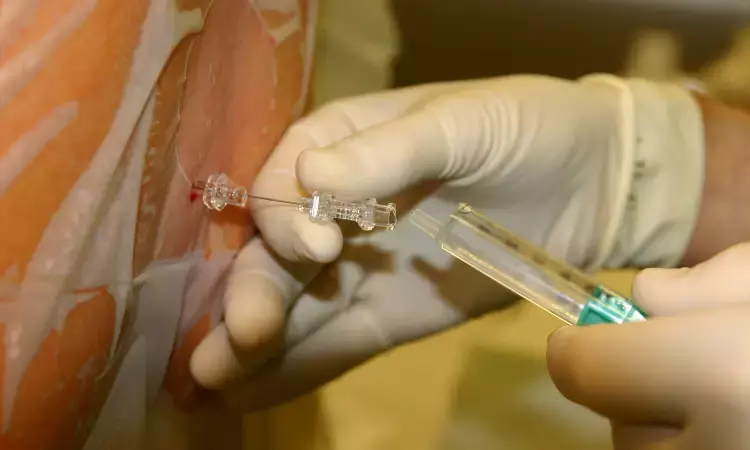- Home
- Medical news & Guidelines
- Anesthesiology
- Cardiology and CTVS
- Critical Care
- Dentistry
- Dermatology
- Diabetes and Endocrinology
- ENT
- Gastroenterology
- Medicine
- Nephrology
- Neurology
- Obstretics-Gynaecology
- Oncology
- Ophthalmology
- Orthopaedics
- Pediatrics-Neonatology
- Psychiatry
- Pulmonology
- Radiology
- Surgery
- Urology
- Laboratory Medicine
- Diet
- Nursing
- Paramedical
- Physiotherapy
- Health news
- Fact Check
- Bone Health Fact Check
- Brain Health Fact Check
- Cancer Related Fact Check
- Child Care Fact Check
- Dental and oral health fact check
- Diabetes and metabolic health fact check
- Diet and Nutrition Fact Check
- Eye and ENT Care Fact Check
- Fitness fact check
- Gut health fact check
- Heart health fact check
- Kidney health fact check
- Medical education fact check
- Men's health fact check
- Respiratory fact check
- Skin and hair care fact check
- Vaccine and Immunization fact check
- Women's health fact check
- AYUSH
- State News
- Andaman and Nicobar Islands
- Andhra Pradesh
- Arunachal Pradesh
- Assam
- Bihar
- Chandigarh
- Chattisgarh
- Dadra and Nagar Haveli
- Daman and Diu
- Delhi
- Goa
- Gujarat
- Haryana
- Himachal Pradesh
- Jammu & Kashmir
- Jharkhand
- Karnataka
- Kerala
- Ladakh
- Lakshadweep
- Madhya Pradesh
- Maharashtra
- Manipur
- Meghalaya
- Mizoram
- Nagaland
- Odisha
- Puducherry
- Punjab
- Rajasthan
- Sikkim
- Tamil Nadu
- Telangana
- Tripura
- Uttar Pradesh
- Uttrakhand
- West Bengal
- Medical Education
- Industry
Subarachnoid spinal anesthesia Safe and Effective Anesthesia Option for High-Risk Obstetric Cases: Study

Recent study discusses the challenges of managing parturients with cardiovascular disease (CVD) during anesthesia, highlighting the increased perioperative morbidity and mortality due to the heightened demands of pregnancy. The preference for regional anesthesia in obstetrics is established, with general anesthesia (GA) and conventional spinal posing risks of hemodynamic instability in CVD patients. The introduction of segmental spinal anesthesia (SSA) has shown promise in providing better hemodynamic stability by confining anesthesia to specific dermatomes, enhancing safety for high-risk patients.
Case Studies of Parturients with Pre-Existing Cardiovascular Disease
The research presented five cases of parturients with significant pre-existing CVD (severe mitral stenosis, aortic stenosis, hypertrophic obstructive cardiomyopathy, and peripartum cardiomyopathy) who successfully underwent cesarean section under SSA at a particular institute from September 2023 to January 2024. The implementation of thorough preoperative evaluation and optimization was emphasized, with a multidisciplinary approach for planning combined epidural and SSA, invasive monitoring, and postoperative intensive care unit (ICU) management. Informed consent and meticulous monitoring were highlighted throughout the procedures.
Anesthetic Technique Employed for Parturients with CVD
The anesthetic technique employed included segmental spinal administration at specific vertebra levels using a combination of bupivacaine and fentanyl to achieve effective blockade and hemodynamic stability. Close monitoring and prompt management of hypotensive episodes with phenylephrine boluses were reported. Postoperative care included ongoing vigilance, epidural analgesia, cardiac function reassessment, and uneventful recovery for all cases.
Discussion on Anesthesia Options for CVD Patients
Different options for anesthesia were discussed, including graded epidural, combined spinal-epidural, and continuous spinal anesthesia, with a preference for SSA due to its muscle relaxation, reduced anesthetic requirement, and stable hemodynamics. The study emphasized the potential risks of GA in CVD patients, suggesting carefully managed GA might be necessary in specific scenarios to ensure patient safety. The findings advocate for SSA as an effective, safe, and viable alternative anesthesia technique for high-risk obstetric cases involving parturients with underlying CVD. The research exhibited successful outcomes, underlining the importance of individualized approaches and meticulous perioperative management to enhance safety and optimize recovery in such complex clinical scenarios.
Key Points
- Regional anesthesia, especially segmental spinal anesthesia (SSA), is preferred over general anesthesia (GA) in managing parturients with cardiovascular disease (CVD) due to the risks of hemodynamic instability associated with GA and conventional spinal anesthesia.
- Five cases of parturients with significant pre-existing CVD successfully underwent cesarean section under SSA, emphasizing the importance of thorough preoperative evaluation, multidisciplinary planning, invasive monitoring, and postoperative intensive care unit (ICU) management to ensure patient safety.
- The anesthetic technique employed involved segmental spinal administration at specific vertebra levels using a combination of medications to achieve effective blockade and stable hemodynamics, with close monitoring and prompt management of hypotensive episodes.
- Different anesthesia options, including graded epidural, combined spinal-epidural, and continuous spinal anesthesia, were discussed, with a preference for SSA due to its muscle relaxation, reduced anesthetic requirement, and stable hemodynamics, highlighting the potential risks of GA in CVD patients.
- The study advocates for SSA as an effective, safe, and viable alternative anesthesia technique for high-risk obstetric cases involving parturients with underlying CVD, stressing the importance of individualized approaches and meticulous perioperative management to enhance safety and optimize recovery in complex clinical scenarios.
- Successful outcomes were achieved with the use of SSA, underscoring the significance of personalized care and detailed perioperative management in improving safety and recovery for parturients with CVD undergoing anesthesia for cesarean sections.
Reference –
Ajit Kumar et al. (2025). Enhancing Recovery In Cervical Spine Surgery With Erector Spinae Plane (ESP) Block- A Case Series. *Indian Journal Of Anaesthesia*. https://doi.org/10.4103/ija.ija_690_24.
MBBS, MD (Anaesthesiology), FNB (Cardiac Anaesthesiology)
Dr Monish Raut is a practicing Cardiac Anesthesiologist. He completed his MBBS at Government Medical College, Nagpur, and pursued his MD in Anesthesiology at BJ Medical College, Pune. Further specializing in Cardiac Anesthesiology, Dr Raut earned his FNB in Cardiac Anesthesiology from Sir Ganga Ram Hospital, Delhi.
Dr Kamal Kant Kohli-MBBS, DTCD- a chest specialist with more than 30 years of practice and a flair for writing clinical articles, Dr Kamal Kant Kohli joined Medical Dialogues as a Chief Editor of Medical News. Besides writing articles, as an editor, he proofreads and verifies all the medical content published on Medical Dialogues including those coming from journals, studies,medical conferences,guidelines etc. Email: drkohli@medicaldialogues.in. Contact no. 011-43720751


